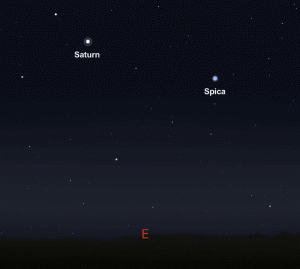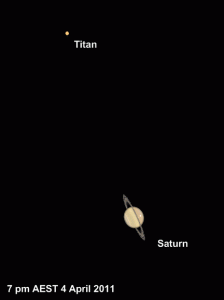
With Saturn reaching opposition Monday night (April 4 2011), now is the time to dust off even a small telescope and point it towards Saturn. Just look low above the Eastern horizon once the sky is dark and you will see two reasonably bright stars. The left of these is the planet Saturn and the right is the star Spica (the brightest star in the ancient Greek constellation Virgo the Virgin).
The term opposition refers to the time of year when a planet is opposite the Sun in the sky. This also usually coincides when the planet is closest to the Earth and therefore ideally placed for viewing, with the naked eye or through a telescope. And just to be clear on something, Saturn will remain visible in the evening sky for some months after opposition. The way an opposition is reported in the media sometimes create the impression that a planet at opposition will be only visible on that particular night. That isn’t true.

If you do happen to own a telescope, point it at Saturn early Monday night and take a close look for a faint star above Saturn. That is Titan, the largest moon of Saturn. Titan has a quite a few claims to fame. Firstly it is bigger than the planet Mercury, it has an atmosphere and has seasonal rivers and lakes filled with liquid methane.
Keep in mind that the finder chart is accurate only at 7 pm AEST Monday night for telescopes which don’t invert the image. In telescopes that do, Titan will appear to be located below Saturn. If you want to look at another time (or date) you will need to generate another chart. Sky & Telescope has a handy applet for doing this on its website here.
2 thoughts on “Dust off your telescope and see Saturn at its best now”